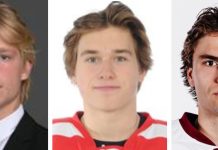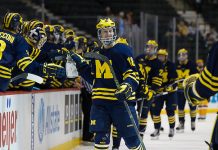It won’t take any sting out of a 5-4 loss to Dartmouth on Saturday night, but the fact that New Hampshire’s Paul Thompson is the nation’s new points-per-game leader makes it a perfect opportunity to look at those players who have emerged as contenders in the Hobey Baker race. This should answer all the “What about?” questions that emerged when I looked back at my preseason 25.
A couple of groups are worth talking about before we get into individuals.
The Atlantic guys: This group consists of Robert Morris’ Nathan Longpre (seventh in the nation with 1.45 ppg) and Denny Urban (second in defenseman scoring with 1.17 PPG), Niagara forwards Paul Zanette and Brian Haczyk (tied for eighth at 1.41 ppg) and RIT’s Andrew Favot (22nd at 1.29 PPG). The fact that there’s five (maybe only four) players in this category creates a problem, because it means there’s a healthy debate about who the best player in Atlantic Hockey is. History shows that Atlantic will get no more than one player in the top 10 Hobey finalists, and when it happens, there’s little to no debate about who the top player in the conference. The smallest points-per-game margin between a Hobey finalist from Atlantic Hockey and the next highest scorer was two years ago, when Jacques Lamoureux of Air Force averaged only .04 PPG more than Mercyhurst’s Steve Cameron, and in that year, Lamoureux was the nation’s leading goal-scorer by a wide margin. Other than that, it was .20 for RIT’s Simon Lambert over Sacred Heart’s Bear Trapp in 2008, .27 for Air Force’s Eric Ehn over teammate Andrew Ramsey in 2007, and .11 for Quinnipiac’s Reid Cashman over Mercyhurst’s David Wrigley in 2005 (a margin made more impressive by Cashman being a defenseman). By comparison, Mercyhurst’s Dave Borelli enjoyed a .09 PPG margin in 2006 and Canisius’ Cory Conacher had a .14 PPG margin last season.
What does all this tell us? Well, there probably needs to be a clear-cut Player of the Year in Atlantic Hockey for there to be a chance of a Hobey finalist from the conference. Still, it’s worth watching these guys in the second half to see if one of them breaks out of the pack. If the top player happens to play for the top team – which is certainly possible with the Purps and Colonials chasing RIT for the conference lead – then the chances of a Hobey finalist from Atlantic certainly improve.
Yale players not named Broc Little – Certainly, Little is Yale’s top Hobey candidate, currently tied for fourth in the nation at 1.59 PPG. However, the Bulldogs did, in the not-too-distant past, boast four of the top seven scorers in the country, so it’s worth asking what the chances are for Andrew Miller, Denny Kearney and Brian O’Neill in this race. Going by the “Hobey likes goals” theory, O’Neill seems like the most likely choice as a second Hobey finalist from the Bulldogs, while Miller seems like the least likely with five goals. Yale’s overall situation recalls last season’s Miami team, where four balanced scorers canceled one another out in the Hobey race, leaving a goaltender, Cody Reichard, as the RedHawks’ representative in the Hobey race. Ryan Rondeau has made a quantum leap from his efforts of a year ago, but I don’t think that he’s Hobey material yet. Keep an eye on Yale’s situation, because someone from this team will be a Hobey finalist, possibly more than one “someone.”
With those groups out of the way – and in all honesty, they’re not major players in the Hobey race – let’s take a look at a few of the new faces who have established themselves as Hobey contenders.
Paul Thompson, F, SR, New Hampshire – Thompson is now the nation’s leading scorer after adding two more points to his season total in Saturday’s loss to Dartmouth, but he’s been great all season. Through 20 games this season, Thompson has only three fewer goals and six fewer total points than he did in 39 games a season ago, and given that he was a point-per-game player as a junior, this is someone who started as a major contributor and took his game to another level. Saturday’s setback doesn’t change the fact that UNH is tied with BC atop Hockey East with games in hand, and as their leader, I’d say that Thompson is a very likely Hobey finalist, with the potential for more if both he and the Wildcats keep it up.
Jack Maclellan, F, JR, Brown – I’ve been pointing out Maclellan’s strong play for a while, and with a goal and an assist in the Bears’ upset of No. 1 Yale today, more people are likely to start taking notice. The problem for Maclellan is that Brown is still sitting in ninth in ECAC Hockey play, but more than half the conference schedule remains to be played, and Brown has gone 1-0-3 against Hockey East teams, with Maclellan averaging 2.25 PPG in those contests. I think Brown is going to climb in the ECAC standings down the stretch, putting Maclellan in solid position to snag a Hobey finalist slot. I think moving further is a stretch at this point, but Maclellan does have one more year in Providence, so he’s a player worth keeping an eye on for the future.
Matt Frattin, F, SR, North Dakota – Until this weekend, Frattin may well have been the hottest player in the country, until an eight-game goal-scoring streak and a nine-game point streak were snapped in Friday’s game against Minnesota. Frattin is still the nation’s leader in total goals, and while North Dakota hit a hiccup against the Gophers, the Sioux appear to have hit their stride much earlier this season than they have in past seasons, and Frattin is a big part of that, making him a strong Hobey candidate.
Justin Schultz, D, SO, Wisconsin – The nation’s leading scorer among defensemen, Schultz has emerged as a successor to Brendan Smith on the Badger blueline. His 1.23 PPG average is just a hair off of Smith’s pace of a year ago, and his 14 goals are more than many of the forwards we’ve discussed this season, including Maclellan, Little, Carter Camper and Andy Miele. I’d be very surprised if Schultz didn’t end up as a Hobey finalist, especially since he doesn’t have the same competition on his own team that Smith did a season ago.
James Mello, G, JR, Dartmouth – Of all the goaltenders who weren’t on the radar at the start of the season, Mello has done the most to put his name into the Hobey mix. He’s got the top save percentage in the country among everyday starters (Princeton’s Sean Bonar splits time with Mike Condon in the Tiger net), he held Yale to one of its worst offensive performances of the season last weekend, and perhaps most importantly, he doesn’t have to compete with a skater for Hobey attention. John Muse’s save percentage is just .006 off of Mello’s, and he’s got two NCAA titles on his résumé, but in the Hobey race, he takes a backseat to BC teammate Cam Atkinson, and maybe even Brian Gibbons. I wouldn’t be surprised at all to see Muse wind up as the first team All-American goalie in the East, but I think Mello’s building a very nice case for himself to earn a possible Hobey finalist spot, especially if Dartmouth can build off of Saturday’s win over UNH and make a run at an NCAA tournament berth.
Jerry Kuhn, G, SR, Western Michigan – Kuhn is No. 8 in the country in save percentage and No. 12 in goals-against average for a Western Michigan team that is just on the outside looking in for an NCAA Tournament berth. With WMU 39th in the country in scoring offense, the burden of getting the Broncos to the NCAAs is going to fall squarely on Kuhn, and if he has them in position to pull it off when March rolls around, look for him to snare a Hobey finalist spot. He’s not going to be the first goalie to win it since Ryan Miller, but he could get a finalist berth.
Scott Greenham, G, JR, Alaska – See above. Greenham is eighth in goals-against average and ninth in save percentage for a Nanooks team that’s in the mix. If the Nanooks are still in the mix in March, Greenham is a candidate for a Hobey finalist spot. If they’re not, he isn’t.
So, that’s where we are. Between these players and the 11 or 12 who are left over from my pre-season list, we’ve still got a group of more than 20 players for 10 Hobey finalist spots, with a handful of players worth watching to win it all.


